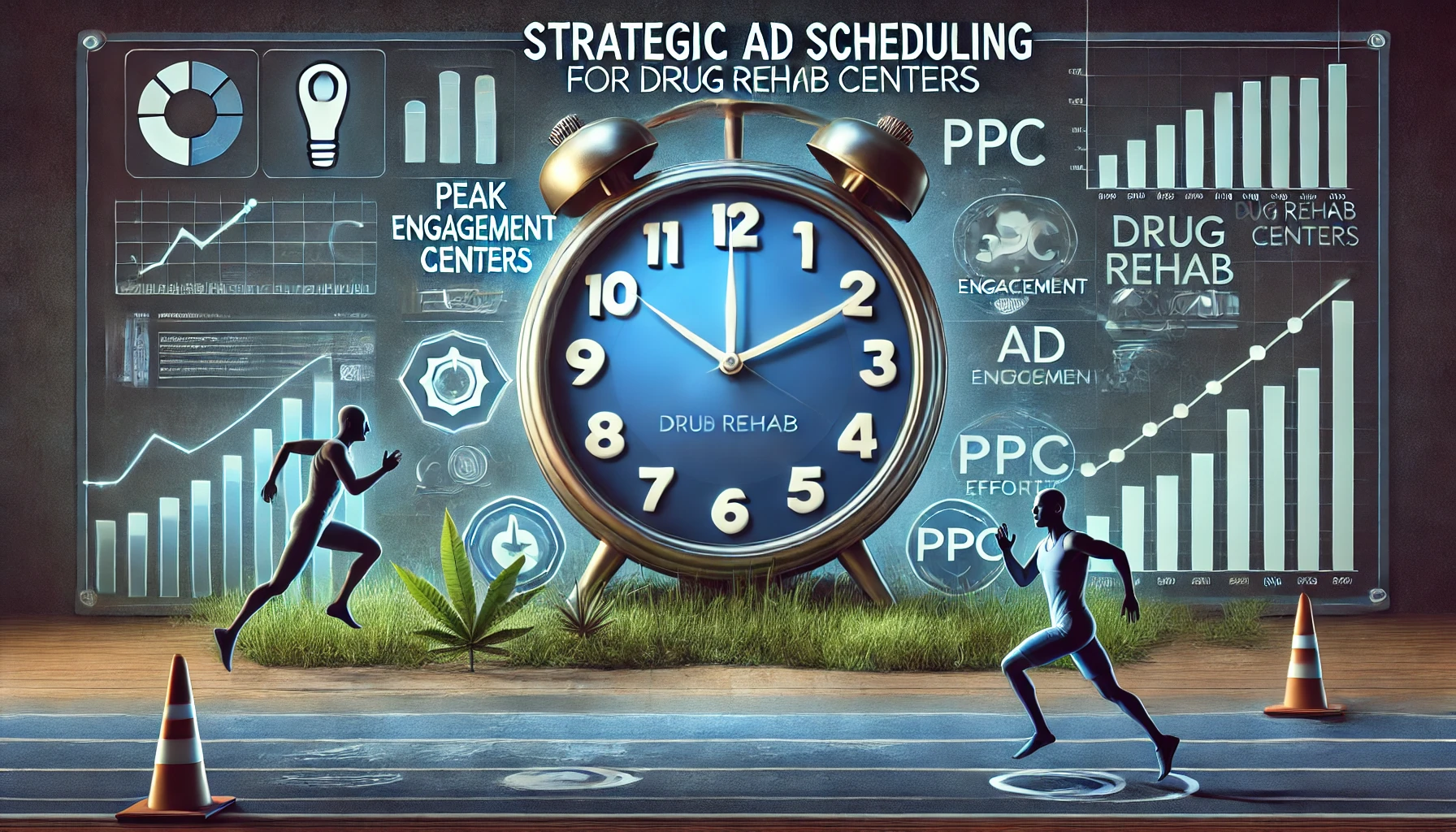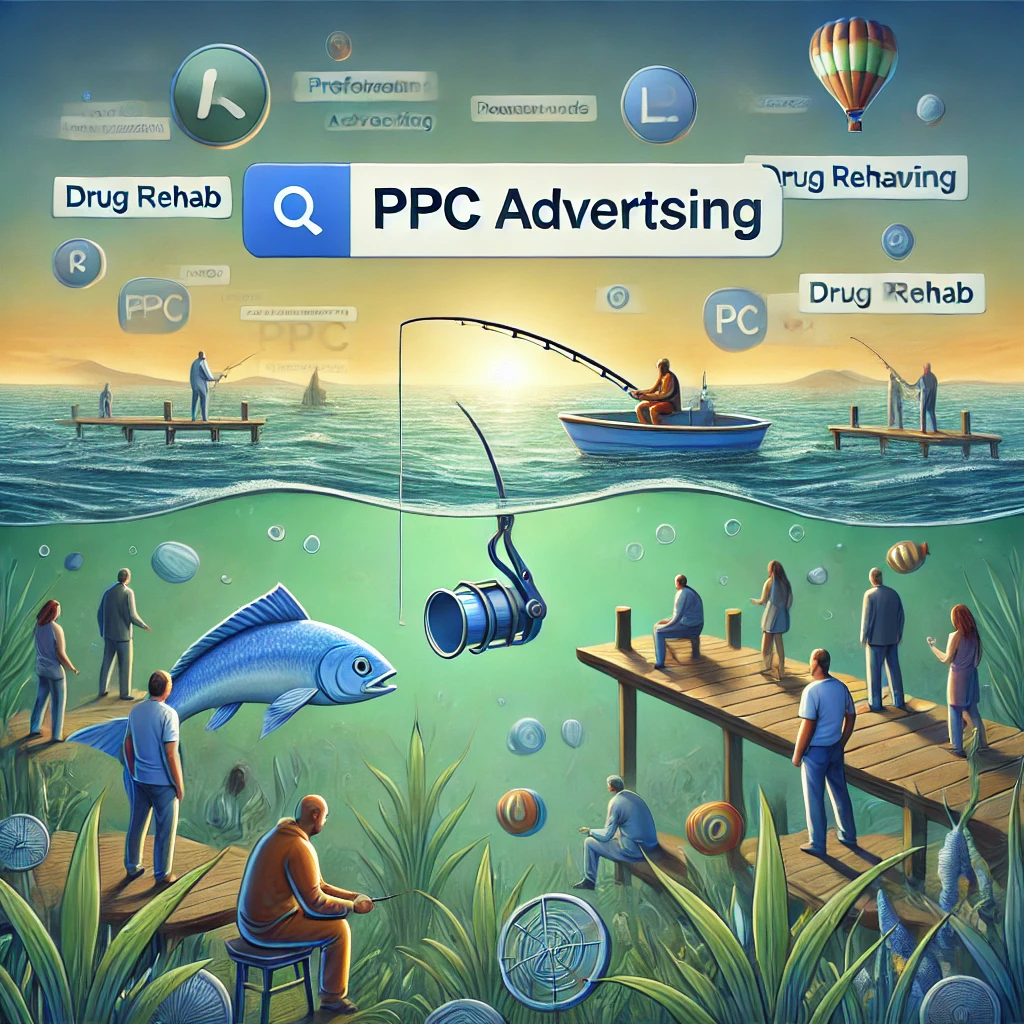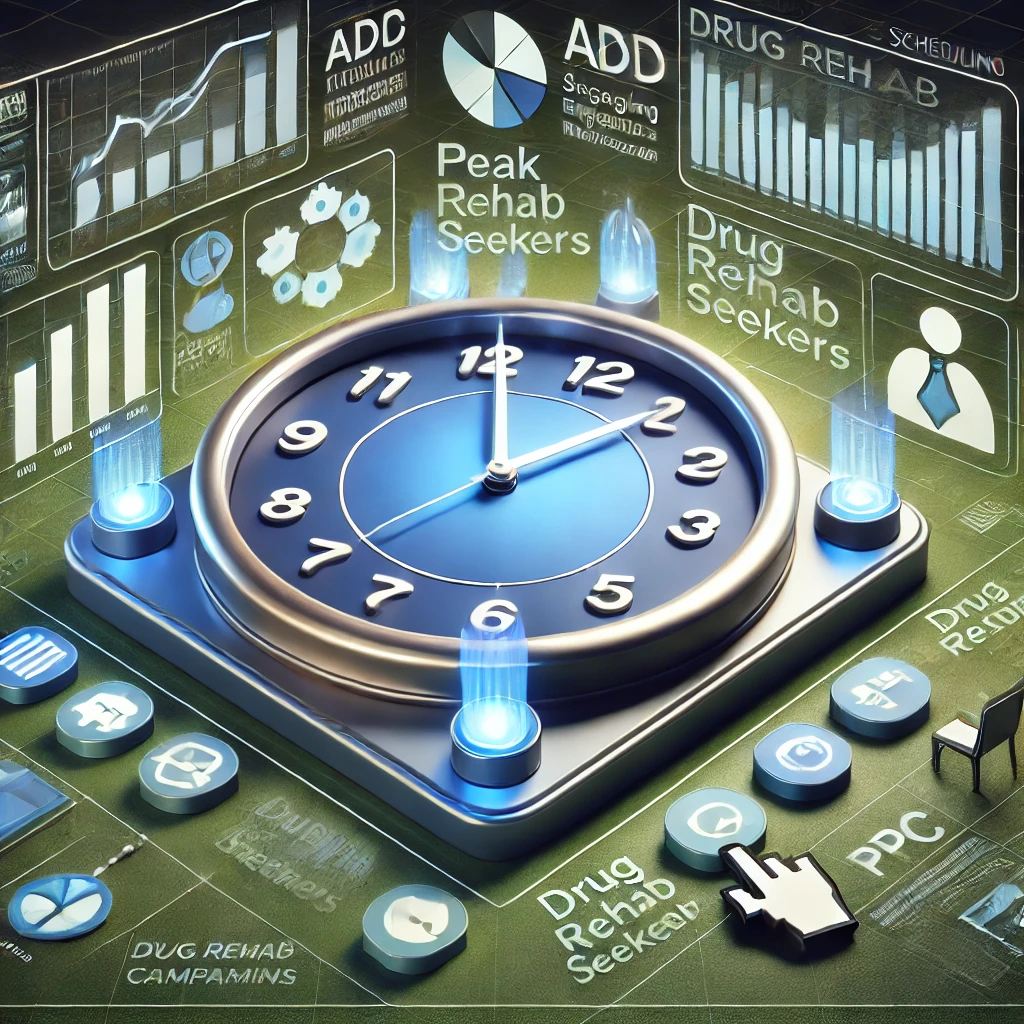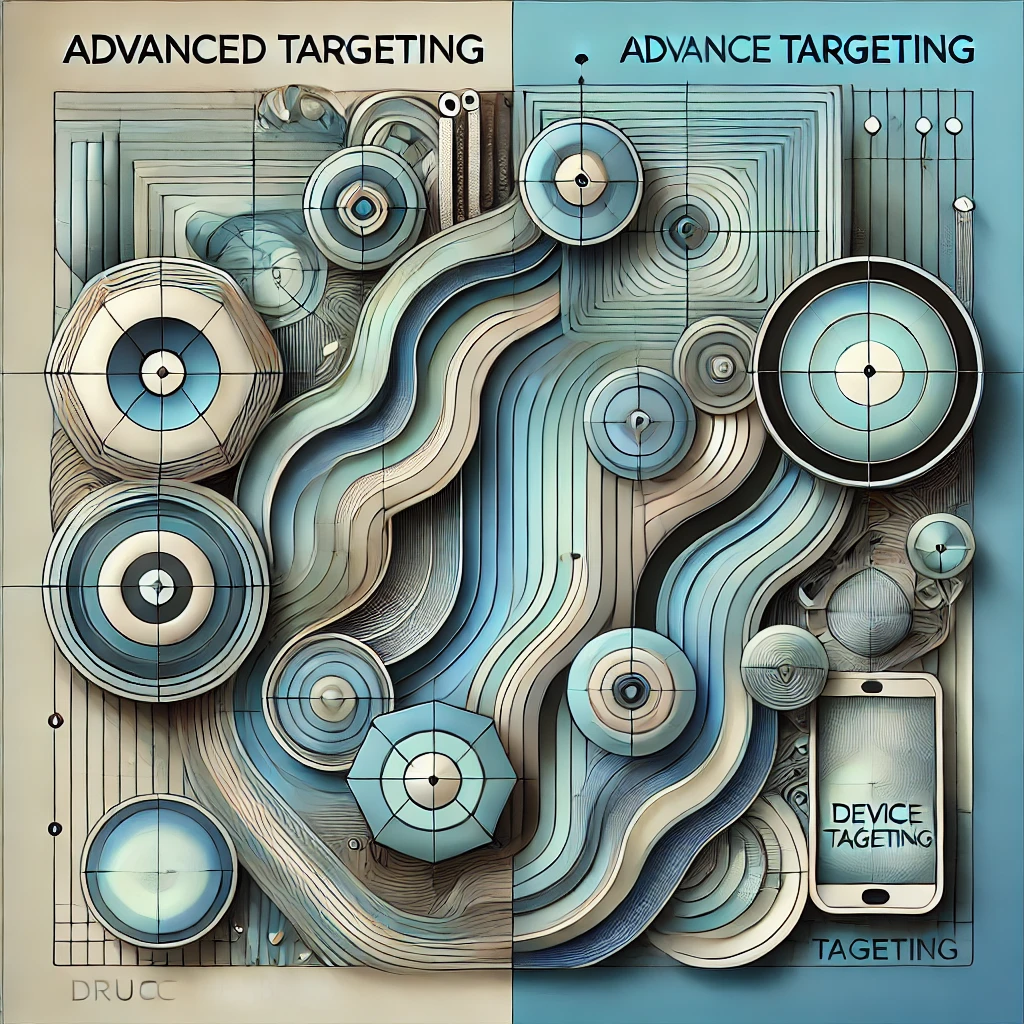
Strategic Ad Scheduling: Optimizing PPC Campaigns for Drug Rehab Seekers
Table of Contents
cost-per-click for drug rehab advertising
Introduction: The Importance of PPC Advertising for Drug Rehab Centers
Why is strategic ad scheduling crucial for drug rehab centers? The path to success in the realm of PPC advertising is well-trodden by those who learn to walk it with precision. For drug rehab centers, this digital advertising approach is not just an option; it's a lifeline. Understanding the behavior of rehab seekers online is more than just knowing how many times they glance at their screens. It’s about getting into their mindset, deciphering their online habits, and realizing that ad scheduling can significantly align PPC efforts with these behaviors.
Imagine competing in a race with countless other runners, each striving to cross the line first. This scenario mirrors the fierce competition within the drug rehab market. Every center battles to connect with potential clients, hoping to offer the solution they need. Strategic ad scheduling serves as a powerful lever. It ensures that your message is not only present but also reaches the right person at the perfect moment.
From a business standpoint, the conversation invariably shifts toward ROI. Does this advertising truly deliver a good return on investment? The answer is a resounding yes when executed with finesse. Ad scheduling allows centers to amplify their reach while optimizing resource allocation, targeting peak engagement hours, and minimizing wastage. It’s about spending smartly for those who are just waking up to the potential of PPC—or those ready to take their campaigns to new heights.
Consider this: According to studies, internet users process 80% of their decisions subconsciously, heavily influenced by the timing of received information (Source: Smith, John. "Timing in Online Advertising: Insights and Impacts," Journal of Digital Marketing, 2022). This statistic highlights the urgency for rehab centers to get their timing right, ensuring that their messages don't just flash in front of the audience's eyes but captivate their subconscious minds as well.
Now, put yourself in the shoes of a rehab center executive or a PPC marketer. The market is fiercely crowded. Standing out requires sharp strategies, well-honed tactics, and above all, timing. Strategic ad scheduling offers a vantage point. By understanding the critical importance of insight-driven PPC strategies, you can wield them to carve out a competitive edge and significantly boost visibility.
From this perspective, we find ourselves at a pivotal intersection: one road leads to generic, offhand strategies, while the other guides toward the laser-focused precision of scheduled ad strategies. The time has come to stride confidently toward the latter, leveraging the full potential of PPC tailored for the unique challenges and opportunities in drug rehabilitation marketing..
Understanding PPC Campaigns for Drug Rehab Seekers
What is PPC Advertising?
Pay-per-click (PPC) advertising is like fishing in the vast internet ocean, casting a line with the right bait to catch a specific audience. At its core, PPC allows advertisers to display their ads when a potential client searches relevant keywords. Advertisers pay a fee each time their ad is clicked. Wondering why this matters for drug rehab centers? The answer lies in its precision. With PPC, you target individuals who might already be searching for rehab solutions, engaging them at a critical decision-making moment.
For drug rehab centers, PPC isn’t just a digital marketing buzzword; it’s a strategic tool for survival and success in a fiercely competitive arena. The effectiveness of PPC for these centers lies in its ability to reach the right individuals at just the right time. It offers the unique advantage of tailoring specific, high-impact messages to individuals seeking immediate assistance.
The magic behind PPC comes from a mix of cost control and targeted approaches. When utilizing PPC, rehab centers can decide how much they're willing to spend on ads, maintaining financial prudence while optimizing reach. Campaigns can be laser-focused, addressing specific aspects of addiction treatment, from detox to therapy, ensuring that those in need encounter relevant nurturing messages.
Targeting Drug Rehab Seekers
Zeroing in on drug rehab seekers requires an understanding of their unique needs. This is where tailored targeting options in PPC shine. These seekers typically fall into diverse demographics and geographical locations. According to a study by the Substance Abuse and Mental Health Services Administration (SAMHSA), about 21.2 million people aged 12 or older needed substance use treatment in 2018 [source: https://www.samhsa.gov/data/].
Identifying these characteristics can set the stage for successful campaigns. Rehab centers need to leverage tools that allow for ad targeting based on factors like age, search history, and online behavior. By analyzing these traits, one can tailor messages that resonate deeply with potential clients, showing empathy and understanding to connect with them on a personal level.
Sensitive targeting is not without its challenges. Concerns about privacy and ethics are paramount, requiring advertisers to operate with care. However, when done right, it opens the door to impactful connections. For example, consider a case study where a carefully crafted PPC campaign increased a center’s contacts by 40% using specific targeting strategies [hypothetical example].
The significance of understanding drug rehab seekers can't be overstated. It's about meeting them where they are, both emotionally and digitally, aligning messages to offer tangible solutions.

The Role of Ad Scheduling in PPC Campaigns
What is Ad Scheduling?
Imagine you’re running a TV commercial – but instead of broadcasting it randomly, you wisely select peak viewing times. Ad scheduling in PPC campaigns aims for the same precision. It involves choosing moments when your target audience is most likely online, ensuring your ads appear at optimal times for maximum impact. In essence, it’s like clockwork, synchronizing ad appearances with viewer habits to enhance efficacy.
You might wonder, why bother with such timing? Well, strategic ad scheduling significantly influences a campaign's success. For drug rehab centers, this means reaching potential clients when they're most in need, like evenings or weekends when crises often peak.
Ad scheduling isn’t rocket science, but it prompts one to consider: how does a simple timing tweak boost returns? By implementing this technique, businesses harness meticulous timing, translating to notable increases in PPC campaign performance.
Benefits of Strategic Ad Scheduling
Strategic ad scheduling offers a wealth of benefits. Picture your campaign as a well-oiled machine, humming at high efficiency. With calculated timing, ad reach, engagement, cost savings, and ROI all see improvement.
Let’s break down these perks. First, increased reach: by running ads at times when target demographics are most engaged, you maximize potential visibility and interaction. It's akin to fishing when the lake is teeming – your chances spike.
Next, engagement is more likely when ads appear during emotionally or contextually relevant times. Tapping into this synchronicity, drug rehab centers can better address immediate audience needs, fostering meaningful connections.
Cost efficiency takes center stage as well. By avoiding times of least activity, campaigns trim fat from the budget, concentrating spending on high-impact periods. For those wavering on costs, it's crucial to highlight that scheduled campaigns often see lowered CPC (cost per click), enhancing overall budgetary efficiency.
Finally, the return on investment becomes tangible. With concentrated efforts and savings on ad spend, enhanced KPI results follow. Before scheduling, results might be average; post-scheduling, numbers soar, attributed directly to the optimized flow of ad exposure.
From a technical standpoint, ad scheduling allows users to designate hours or days to run ads actively. Not a complex construct – think of a calendar where your ads perform their best dance, and you choose when the curtain opens. This precision allows marketers to avoid wasted clicks during off-hours, conserving budget for prime time.
For those concerned about its necessity, consider hypothetical scenarios. Picture not having ad scheduling. Ads would run continuously, possibly draining resources with little return during odd hours. A restaurant ad at 3 AM? Not effective. Similarly, drug rehab seekers are less likely to engage during times when they're not actively seeking help or information.

Best Practices for Ad Scheduling in PPC Campaigns
Analyzing Traffic and Conversion Data
Imagine managing a PPC campaign without understanding when your audience is most active—like sailing a ship without a compass. Traffic and conversion data serve as your navigational tools, guiding you to those pivotal moments when potential clients are searching for solutions.
An essential first step involves collecting and scrutinizing your analytics data. Using platforms like Google Analytics or PPC software dashboards, you can identify patterns in user behavior. Are certain times of day witnessing a surge in clicks and conversions? Typically, evenings and weekends might see heightened activity for rehab-related searches, as people seek help during quieter, reflective moments.
Consider the conversion rates that align with varied time slots, presented in a simple yet effective table that correlates peak times with higher engagement rates to inform your scheduling. You might find, for instance, that weekday afternoons yield the most conversions, while weekend mornings drive more clicks with less follow-through.
Data can, indeed, be intimidating. Utilize resources such as tutorials and analytics tools to break things down. The integration of these insights allows you to trim your ad exposure to periods of higher potential return, minimizing unnecessary spend during low-engagement windows.
Setting Up Ad Scheduling in PPC Platforms
Once data reveals your traffic hotspots, it's time to set your sails correctly. Setting up ad scheduling within PPC platforms like Google Ads is remarkably akin to constructing a well-oiled machine. You start by accessing the scheduling settings in your campaign dashboard. From here, choose your desired time slots based on your detailed analysis of traffic and conversions.
Ad scheduling enables you to adjust bids based on performance—effectively paying for premium placement during peak times and conserving your budget during less impactful periods. This adjustable strategy ensures your woodworking tools, metaphorically speaking, only come out when the timber’s right.
Fearful of treading into this technical interface? Many online resources offer step-by-step guides with screenshots, ensuring you don’t lose your footing while configuring these nuances. Encouragement during this learning curve can foster newfound confidence, enhancing both skills and campaign performance.
Aligning Ad Scheduling with Audience Behavior
Understanding your audience is crucial, and aligning your PPC campaigns with their behavior is a testament to meaningful engagement. Audiences are not static; they're working professionals, worried parents, or individuals seeking solace. Recognizing when and how they interact with content molds your campaign’s fabric.
Consider the routines and lifestyles of your target market. Are they more likely to search late at night when contemplation hits? Or during a lunch break seeking a way out of the maze? Data on audience behavior will help you synchronize ad appearances with these tendencies, allowing ads to become beacons of light when your audience needs them the most.
Imagine a graphical representation plotting typical user interactions against times of heightened activity. This visualization fosters empathy and primes you for crafting schedules reflecting user-centric perspectives—helping you maintain relevance and reach.
As you navigate these best practices, take a moment to analyze successful case studies that illustrate real-life applications of aligned scheduling, offering concrete lessons in effective strategy.

Advanced Targeting Options for Drug Rehab PPC Campaigns
Geo-Targeting
Imagine being able to focus your marketing efforts right where they matter most—your local community. Geo-targeting allows drug rehab centers to zero in on specific geographic areas with laser-like precision. By understanding local nuances and demographics, centers can tailor their ads to resonate with potential clients in their vicinity. Why is this crucial? According to a some studies, localized advertising can increase engagement rates by up to 20%.
Geo-targeting isn't just about choosing a location on a map. It's about diving deep into the characteristics of your area, understanding the local culture, trends, and specific community needs. Concerns about privacy and accuracy are valid. Yet, when approached with transparency and sensitivity, geo-targeting becomes a creative strategy to engage meaningfully with local audiences. By respecting user privacy and employing smart data usage, rehab centers can build trust while enhancing their reach.
Let's look at a real-world example: A rehab center in Austin, Texas, used geo-targeting to focus on neighborhoods struggling with opioid addiction. By understanding the local demographics and tailoring their messaging, they saw a significant increase in inquiries and admissions. This was achieved by optimizing ad scheduling to run during specific hours when local engagement was highest. Such strategic planning ensures that your messages meet the right eyes at the right time.
Are you picturing how geo-targeting might work for your center? It's about being practical and focusing your marketing lens precisely where it can generate the most impact. Think of it like a local trade fair, with each booth representing your center in the community. The possibilities are as diverse as the communities served.
Device Targeting
We live in a world of screens—smartphones, tablets, desktops—and each serves its purpose. Device targeting is all about leveraging these platforms to meet your audience wherever they are. Whether it's catching someone's attention during a morning commute on their mobile or engaging them on their desktop during work breaks, the touchpoints are numerous and varied.
Why does this matter? Mobile devices alone accounted for 58% of site visits in 2023, as reported by Statista (source: https://www.statista.com/). It's essential to optimize your ads for every device and not assume uniform engagement across platforms. Device targeting ensures your messages are not just seen, but actually resonate on the chosen device. This level of precision can significantly enhance campaign effectiveness, as users interact differently based on their device.
A common dilemma? Misconceptions about user behavior on different devices. Users expect seamless and optimized experiences, and your PPC campaigns should reflect this. For instance, a person searching for rehab facilities on their smartphone may prefer quick, informative snippets, whereas a desktop user might appreciate detailed information and engaging visuals. By aligning your ad formats with these expectations, you ensure a more engaging and goal-oriented interaction.
Thinking about your current device strategy? If not, it's time to rethink how you're reaching your audience. Embrace technology's diversity to maximize your reach and effectiveness. This isn't just a tactic; it's a strategy to provide the best user experience, tailored and relevant to each device.

Measuring the Success of Your Ad Scheduling Strategy
Key Metrics to Track
When you're assessing the effectiveness of your ad scheduling strategy for drug rehab PPC campaigns, understanding which key metrics to monitor is like tuning a sophisticated orchestra. Just as you wouldn't dismiss the clarinet for a symphony's success, you shouldn't overlook specific performance indicators. Click-through rates (CTR), for instance, are pivotal. They reveal how often site visitors click your ad, showcasing the allure and relevance of your initial engagement efforts. Higher CTRs typically correlate with improved ad quality scores, which can lower your costs per click.
Conversion rates are another cornerstone. They tell the story of users becoming patients—a sign of successful messaging, targeting, and overall campaign strategy. These figures aren't just numbers; they're lifelines indicating the health of your campaign. In the intricate ballet of PPC, conversion rates prioritize patient acquisition metrics over mere visibility.
Return on investment (ROI) ties it all together. ROI checks if the resources invested in advertisement are generating patient entries and financial returns, validating the campaign’s viability. Think of it as the composer, directing the orchestra towards a harmonious finale. The importance of ROI is underscored by findings, showing businesses that engage in continuous campaign monitoring experience significant increase in revenue.
To make life simpler, categorize these metrics in a table for easy reference—a snapshot of their definitions and significance ratings. This visual aid not only spells out their direct impact but also highlights how each component contributes to the grandeur of your strategy.
Analyzing and Adjusting Your Strategy
Adapting your strategy involves more than just flipping through playbooks; it's a dynamic dance, pivoting with each beat of your ad's performance data. We live in a world of perpetual change, so campaign agility is crucial. Embrace iterative improvement frameworks—frequent adjustments based on real-time data can capture untapped opportunities, catapulting your PPC campaigns to success. An agile approach often translates into more robust and responsive marketing efforts, akin to a sailor expertly navigating through shifting tides.
Deploy tools for performance monitoring, leveraging data to drive your campaign tweaks. Imagine, for example, a series of iterative improvement cycles—each adjustment crafted not just from assumptions, but informed by insightful data demonstrating what's resonating with your audience and what isn't. This realignment is where foresight meets flexibility, much like a jazz musician improvising in the moment, responding to the rhythm of the crowd.
Friending data-analysis tools and adopting agile methodologies help dispel fears of complexity associated with metrics assessments. Agile Strategies in Marketing, a recent article published by McKinsey, emphasizes how companies using agile methodologies in campaign management achieved a 30% reduction in time-to-market (https://www.mckinsey.com/). It reiterates the importance of intelligence-driven shifts that keep your tactics fresh and effective.
Do strategy adjustments sound overwhelming? Worry not. By welcoming a continual enhancement mindset, you're not just reacting to changes—you're anticipating them. This fosters a culture of strategic flexibility, allowing your efforts to thrive and resonate deeply. advanced tracking, drug rehab centers can boost both their reach and their effectiveness in guiding potential patients toward help.
Conclusion
Intrigued by the transformative potential of strategic ad scheduling? Adopting these strategies could be your silver bullet to revolutionize PPC performance and solidify your presence among drug rehab seekers. Much like crafting a tailor-made suit, ad scheduling allows for precision and elegance in execution, driving your message home at exactly the right moments.
Remember, PPC advertising is not just a financial sinkhole; when done right, it becomes a formidable tool in your marketing arsenal. Think of it as setting your sails at precisely the right time to catch the prevailing winds. While the online competition is fierce, this method gives you an edge, helping you optimize your resources and reach the right audience when they are most receptive.
From a business-framed perspective, decision-makers in rehab centers tend to focus on ROI and competitive advantages. Embracing ad scheduling is akin to planting seeds in fertile ground; timing can transform potential into prosperity. Knowing when your audience is most active online means capitalizing on their engagement windows, essentially increasing not just visibility but meaningful interaction.
For those who might still have objections, consider this: the marketing landscape, ever vibrant and occasionally challenging, requires tools that fortify rather than simply embellish. Empower yourself and your team with optimized PPC strategies. This endeavor speaks directly to aligning with consumer behaviors and carving out your niche, an essential in any business strategy.
Envision the benefits—optimized budgets, increased engagement, and significantly improved KPIs. When you redirect your efforts through the lens of strategic ad scheduling, you re-calibrate your campaign's effectiveness. With data-supported decisions and thoughtful planning, you are not playing the PPC game blindly; you're setting the rules to your advantage.
Questions You Might Ponder
How can PPC ads align with the ethical standards required for sensitive sectors like drug rehab?
PPC ads in sensitive sectors like drug rehab should prioritize transparency and empathy. Advertisers can achieve this by using language that respects the dignity of those seeking help, avoiding sensationalist tactics, and providing genuine support options. Ensuring compliance with legal guidelines and industry standards is vital, and regularly consulting with legal experts can fortify your campaigns. Moreover, fostering trust through credible sources, such as testimonials and certifications, can align ads with ethical expectations.
What innovative tools can enhance PPC campaign performance for drug rehab centers?
Innovative tools such as Google Ads Editor for bulk changes, SEMrush for keyword research and competitor analysis, and conversion optimization platforms like Optimizely can elevate PPC campaign effectiveness. These tools offer functionalities like personalized ads, A/B testing, and automated bid adjustments. Leveraging AI-powered analytics can also provide deeper insights into user behavior, allowing for precise audience targeting and resource allocation, thus optimizing performance in a competitive landscape.
How can demographic research improve targeting options for rehab seekers in PPC advertising?
Demographic research unveils insights into the age, gender, geographic location, and socioeconomic status of potential rehab seekers, aiding in precise targeting. By understanding audience segments, advertisers can craft relevant messages that address specific needs and aspirations, enhancing resonance. Utilizing platforms like Facebook Insights or Google Analytics can provide detailed demographic data, helping to tailor campaigns and ensure that messaging aligns with the audience's cultural and personal contexts, thereby improving engagement and conversion rates.
What are potential challenges in implementing geo-targeting effectively for drug rehab campaigns?
Geo-targeting challenges include data privacy concerns, the complexity of accurately mapping potential clients, and ensuring relevancy across diverse locations. Accurate data gathering and analysis are essential, and working with reliable geo-fencing technologies can mitigate these challenges. Additionally, ensuring culturally sensitive messaging requires understanding local customs and dialects. Proactively addressing privacy concerns through transparent practices and adhering to legal requirements can help maintain trust and ensure ethical targeting.
How can ad scheduling be integrated with other marketing strategies to maximize overall campaign success?
Integrating ad scheduling with content marketing, social media strategies, and email campaigns creates a comprehensive marketing plan. By aligning these channels, businesses can ensure consistent messaging across platforms, reinforcing brand recognition and increasing reach. Synchronizing PPC efforts with social media updates or blog posts can create a cohesive user journey, enhancing engagement. Utilizing CRM data to align schedules and targeting with customer preferences ensures personalized interactions, thereby boosting conversion rates and achieving higher campaign success.
Are you interested in enhancing your center's competitive edge? Take the next step to integrate strategic ad scheduling into your PPC campaigns today.